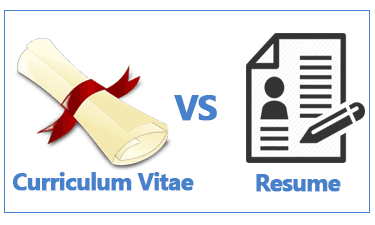CV vs. Resume: Know the Difference

posted:4 years agobyAwatef Hamdiin CVs
A resume and a CV are two prominent terms in the job search industry. Some applicants think that both labels are the same. Others believe that there is a difference between a resume and a CV. In this article, we will compare both entities and present the common and the differences between them. To realize these steps, we need to introduce each document. Let’s get started.
- What Is a Curriculum Vitae?

A curriculum vitae (CV) is a document which includes a summary of the applicant’s experience and skills. A CV is composed of two or three pages in length for an entry-level application. It might exceed this page number if it was for mid-level candidates. A CV’s content provides extensive details on the candidate's academic background, degrees, research, awards, experience, publications, presentations, and many other achievements. This stuff makes a CV looks longer than a resume, as it includes more details concerning studies and background. For more info on CVs, visit this link:
What you Must Know About CV Definition Template and Maker
- A CV Summary
Since resumes include a resume summary statement, a CV includes a summary too. A CV summary is also long. It is a one or two pages. It offers in quick and clear statements, a summary about the candidate’s skills and qualifications. The details included in the CV’s summary depend on the nature of the job position. Some large companies expect a one page CV summary as they deal with huge number of applicants.
- Components of a Curriculum Vitae
Like resumes, a curriculum vitae includes contact information, education, skills, and experience.
Adding to these elements, a CV introduces more details such as research, publications, professional exchange, or fellowship. It also includes positive references, such as licenses, awards, and other relevant achievements.
After exploring CVs from different angles, let’s take a look on resumes to understand the differences. Fore more guidance concerning CVs, check this article;
How to Write A CV Curriculum Vitae to Win a Job
- The definition of a Resume
A resume is a must-have in every job application. It is composed of many sections including a summary of the applicant’s education and credentials, skills, and qualification. A resume has also optional sections, including such as a resume objective statement and a resume summary statement. Unlike CVs, a resume must be as brief as possible. In fact, resumes don’t exceed two pages in length. Typical resumes are short and follow specific formatting. We have mentioned in a previous article that there are three types of resume formats; chronological, functional, and combination formats.
Understand Resume Meaning and Design
The difference between a resume and a curriculum vitae (CV)

The differences between these two documents are:
- Length
- Content
- Purpose
Although both documents are used for job applications, each document operates in a specific field. On the one hand, resumes are used in less requiring job positions, or short term projects such as marketing, freelancing and skill based jobs. On the other hand, a CV is required in highly qualified jobs such as medicine, education and finance. In other words, a CV can not be used instead of a resume.
CV and Resume Writing Tips
A job applicant has the choice between writing a resume or a CV. This task depends on the job position that the applicants intend to have. There are many common tips that work for building both documents.
1. Matching:
An applicant should first match the resume or CV to what is stated in the job description position. This is a common step that occurs while writing a resume or a CV. In this respect, the applicant should present information that highlight education, work experience, and skills.
2. Headings and details:
Headings depend on the job position. They might be similar too. However, the content inside each document is quite different. For instance, in a CV for a teaching job, teaching experience should be put at the top of a CV.
However, in a resume, work experience is mentioned in the resume objective statement. Both documents are built upon the same keywords that were put in the job description. A CV includes more details that more focus on academic degree and achievements. These detailed educational descriptions would draw the difference between applicants, since employers would select the most educated applicants.
Do I need to Put Interest in Resume?
3. Template.
Both resumes and CVs are written and put inside templates that offer better-illustrated information. Templates give a nice structure to a resume or CV.
Choosing an eye-catching and interesting template would help the candidate to illustrate his document in a clear organization. Moreover, it helps the employer earn time by reading a specific section rather than the whole document.
4. Proofreading.
A CV or resume requires proofreading. These documents reflect everything about your education, qualifications, and skills. Proofreading is very mandatory because both documents will be handed to experts, who would not tolerate grammatical or spelling errors. Therefore, an applicant needs to be careful while editing a CV or a resume.
5. Formatting:
Many applicants don’t give formatting a big deal. However, little do they know about the importance of formatting. The way sentences and words are put plays an important role in presenting information about the applicant. Therefore, they need to use headings and bullet points to separate between sections.

These were the common and different points between a CV and a resume. If you are a job seeker, consider this article with additional integral links to craft a perfect job application document.
